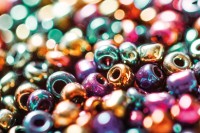Japanese automotive manufacturer TOYOTA started to request high heat yellowing performing articles measured by their test method TSL5101G 3.23 using the conditions of 110°C for 400hrs. The specifications for finished leather use the GS (Grey Scale) and a Grade >4 and Delta E must be <3.8 with no extraordinary change.
HONDA, on the other hand, use heat resistance test method JIS L 0804 / 8102 that is performed in a bottle (250 cm3) with the test conditions of 110°C for 200hrs and 120°C for 120hrs. Specifications for finished leather use the GS and a Grade >4 with slight change but not evident and Delta E specification of <2.0.
How to achieve high heat fastness requirements?
From the formulation point of view, it is very important to select a suitable wet-blue or wet-white from the outset, especially with an acceptably low content of residual natural fat content. However, from the chemical point of view, the major source of poor heat yellowing values are the natural based fatliquors and certain synthetic tanning agents that, although may have a very good whitening effect, may be susceptible to yellowing on exposure to heat (see pictures on the following page).
Why LEVOTAN® HPP?
The chemistry of LEVOTAN® HPP achieves the highest heat yellowing requirements giving the possibility to combine or to replace 100 % of the standard automotive fatliquors depending on the article required, chrome or chrome-free.
The partial replacement of synthetic tanning agents is also possible by using the right balance between acrylic polymers (e.g., MAGNOPAL® and/or LEUKOTAN® range) combined with protein fillers such as SELLASOL® FSU.
The application of LEVOTAN® WS in combination with, for example, LUBRITAN® GXL can impart to the leather excellent softness and tightness after the milling process, especially with chrome-free material.
LEVOTAN® HPP is a biodegradable, compostable and yet oxidation resistant (fatty acid-free), the odorless polymer. It also possesses extreme fastness under heat and light exposure without the risk of Chrome VI formation.
As fatliquoring has a strong impact on these requirements, LEVOTAN® HPP was specially designed to replace up to the complete offer of natural based fatliquors and confer excellent performance on automotive articles such as fogging gravimetric, reflectometric and haze, as well as extremely low emissions and COD values.





 Main Reaction - The TFL Blog Stories, incidents, tips and facts around the topics leather, chemistry, fashion, sustainability and ecology. Our editorial staff consisting of experienced tanners, scientists, market experts, fashion and communication specialists has sharped their pencils and will supply you with fresh and inspiring content on a regular basis.
Main Reaction - The TFL Blog Stories, incidents, tips and facts around the topics leather, chemistry, fashion, sustainability and ecology. Our editorial staff consisting of experienced tanners, scientists, market experts, fashion and communication specialists has sharped their pencils and will supply you with fresh and inspiring content on a regular basis.


 LEVOTAN® / LUBRITAN™ - Looking for higher performance? Tanners around the world are facing increasing challenges from their customers, for example, demands for higher performance such as fastness to light and heat resistance, but also lighter weight leather and more recently odour / emissions avoidance.
LEVOTAN® / LUBRITAN™ - Looking for higher performance? Tanners around the world are facing increasing challenges from their customers, for example, demands for higher performance such as fastness to light and heat resistance, but also lighter weight leather and more recently odour / emissions avoidance.



















